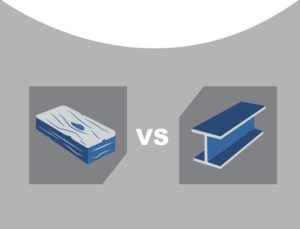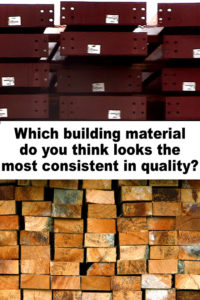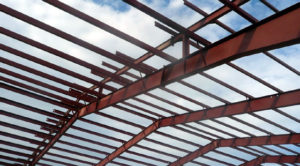Wood vs. Prefab Metal Buildings in Natural Disasters
Let’s look at how RHINO prefab buildings and wood-framed structures perform under pressure.
Building for Endurance
 When building, it is important to think long-term.
When building, it is important to think long-term.
First, what are the natural challenges facing structures in your location?
Secondly, how safe is the structure you plan to build? How will it hold up against earthquakes, fire, violent storms, or termites?
Termites vs. RHINO Prefab Buildings
 WOOD: Lumber-framed structures invite termites, wood ants, and vermin in for a snack.
WOOD: Lumber-framed structures invite termites, wood ants, and vermin in for a snack.
Wood building owners must either pay hundreds of dollars for harsh chemical treatments to hold wood-munching critters at bay— or thousands of dollars in repairs when the insidious termites damage the structure.
STEEL: Even the most determined Formosan termite cannot make a meal of steel.
RHINO prefabricated buildings never attract termites, wood ants, vermin, or mold— nor do they need repeated, expensive chemical termite treatments.
Lightning vs. RHINO Pre-engineered Metal Buildings
Did you know that Americans pay almost one billion dollars annually for lightning damage?
WOOD resists electrical current. The lumber’s moisture content causes wood framing to detonate when struck by lightning. The voltage can shoot outward and strike nearby people or objects.
STEEL is a great conductor of current. If lightning strikes a metal building, the current passes through the steel, dispersing harmlessly into the ground. Consequently, well-grounded steel buildings actually resist lightning damage.
Wind vs. RHINO Prefab Metal Buildings
 WOOD: Hurricane-force winds may breach a structure by punching through windows or large door openings, like garages doors.
WOOD: Hurricane-force winds may breach a structure by punching through windows or large door openings, like garages doors.
The wind produces lift. The nail and staple connections commonly used in wood framing fail under such extreme pressure. The roof lifts and blows off the building. Without the roof, the walls topple.
STEEL: RHINO’s commercial-grade rigid-steel buildings combat high winds with stronger components and stouter connections. The high-strength steel bolts and nuts uniting steel-framing members withstand greater wind forces than wood structures.
In addition, RHINO offers optional-wind-resistant overhead doors for their pre-engineered metal buildings in hurricane-prone areas.
Fire vs. RHINO Pre-engineered Steel Buildings
According to the latest statistics from the National Fire Protection Association, U.S. fire departments respond to 1.3 million fires per year.
So, when comparing wood to steel prefab buildings, which one promises greater safety from life-threatening fires?
WOOD is combustible. In fact, the wood framing is the second most likely place for a structural fire to start.
Once a blaze ignites, lumber continues to feed the fire. That is one of the reasons firefighters dread calls to a lumberyard blaze.
STEEL: Fire-resistant steel framing never becomes the point of ignition in building fires. Nor will steel framing add fuel to a structural fire.
Consequently, the non-combustible nature of commercial-grade prefabricated buildings earns lower premiums with most insurance companies.
However, light-gauge steel framing does not hold up as well as RHINO’s rigid-frame steel framing during a fire.
Although light-gauge steel is non-combustible, the steel loses its strength quickly when in intense fires. Light-gauge steel framing collapses without warning. Therefore, firefighters hate light-gauge steel building fires.
Earthquakes vs. RHINO Pre-engineered Metal Buildings
WOOD: Under the stresses of a seismic event, wood studs snap and connections fail.
 STEEL: The heavy-duty steel bolts and nuts joining pre-engineered steel systems create moment frames. During an earthquake, moment connections allow framing to move slightly, absorbing the lateral forces caused by shaking.
STEEL: The heavy-duty steel bolts and nuts joining pre-engineered steel systems create moment frames. During an earthquake, moment connections allow framing to move slightly, absorbing the lateral forces caused by shaking.
The Federal Emergency Management Agency (FEMA) calls steel moment frames “one of the best earthquake resisting systems available.”
However, weld-up steel buildings— where the framing pieces are welded together rather than bolted— do not perform well in earthquakes. Welded connections may break during a tremblor.
Conclusion
Prefabricated steel buildings outperform wood structures in natural disasters.
RHINO Prefab Metal Buildings: Stronger, Safer, Smarter Construction
Of course, no building system can claim to be impervious to natural disasters.
However, when examining steel vs. wood buildings, it is clear that pre-engineered steel buildings typically resist external pressures better than lumber-framed structures.
Please call RHINO Steel Building Systems now. Discover the benefits and strengths of our strong, durable and practical steel prefabricated buildings.
You can talk to a friendly RHINO metal building specialist by calling 940.383.9566.
And don’t forget to check out our Steel Building Specials.
(Updated 6-10-2020. Originally published 4-5-2016.)
